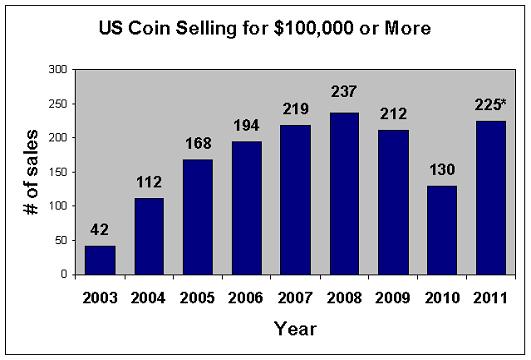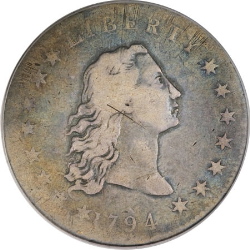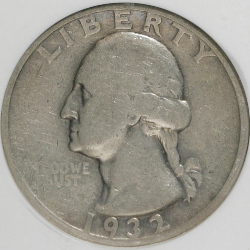Investors Create Additional Demand for Rare US Coins
A decade ago, few coin collectors could envision spending $100,000 or more for a coin. Back then, the sale of a US coin crossing into six figure territory was headline news in the numismatic world. Today, such an occurrence is commonplace and is largely relegated to the fine print of the” Prices Realized” reports.
The graph below illustrates the number of regular issue United States coins sold in public auctions for $100,000 or more in the years 2003 to 2011.

Image 1: In 2003, there were 42 coins sold at public auctions for $100,000 or more. As the decade progressed, this number increased dramatically, as did the market for rare US coins overall. When the economy slowed in 2009 and 2010, the number of $100K coins plunged, but we are seeing a recovery in 2011*. (Table above shows estimated sales at year end).
The unbelievable explosion in the number of coins topping $100K parallels the price movement of rare US coins in general. According to the monthly index maintained by the US Coin Values Advisor website, the market value as a whole for coins of numismatic significance more than tripled between 2003 to 2011. Nearly every year during this span showed strong advancement.
What has caused the dramatic climb in rare coin values? Who is it that is propelling the market to such stratospheric heights? Is it the average hobbyist? For sure, many thousands (or is it millions?) of new collectors have joined the party in recent years, but it is well-heeled buyers with investment motives who have created much of the additional demand for very high dollar numismatic material.
Approaching United States coins from the investment angle is not a new idea. Once upon a time, telemarketers littered the numismatic landscape, promoting overgraded, not-so-rare coins onto legions of trusting buyers, promising fantastic rates of return and guaranteed buybacks. These boiler room operations fueled coin market booms in the 1970’s, 80’s, and 90’s, but all ended in a crash because so much of the speculation was built upon faulty numismatic fundamentals.
Is the run up we’re now experiencing destined for the same sad fate? Thankfully, this time around, we appear to be standing on solid ground, so expect most of the gains to stick as we move forward. The fact that the upward pressure has been sustained for so many years is a good indicator of stability, not just a passing fad. Why, then, is so much big money readily pouring into rare coins nowadays? There are a couple of things in place at present that didn’t exist in previous boom cycles:
• Greater standardization in coin grading. Most of the rare coins of high value trading hands in today’s marketplace have been certified by a third party grading service. The biggest and most reputable of these are PCGS and NGC. Both companies trace their origins back to the 1980’s and are known for their tough standards and consistency. ICG and ANACS are also well respected. Coins with grading labels affixed by these services inspire greater confidence among buyers and improve liquidity. One of the primary concerns of potential coin investors in decades past was the possibility of acquiring coins with inflated grades.
• Internet activity. The widespread availability of the Internet has expanded the coin universe immeasurably. For buyers, the selection has never been better or more instantaneous, while sellers have access to huge audiences. High quality online digital photography has helped bridge the gap between the two groups. What’s more, the free flow of information gives collectors and investors the opportunity to do their own research into pricing trends, dealer character, and numismatic histories before making the plunge.
Despite today’s relative grading stability, increased liquidity, and higher price momentum, the road to success for the aspiring rare coin investor is not without potholes. If price appreciation is important consideration, there is no substitute for numismatic knowledge when choosing an investment quality coin. Important points to contemplate are:
• Is this a key date with a proven track record of demand by coin collectors? If so, expect lots of fierce competition among bidders come the day you decide to sell.
• If the coin is a common date, does it have a big price tag because it is in Uncirculated or Proof condition, or is it actually one of the finest known specimens of the date and truly rare? Too many hopeful investors with limited information purchase collectible coins with excellent eye appeal that generally increase in value slowly because the supply is fairly plentiful compared to demand. “Generic coin” is the lingo term for this type of performer.
Coin buyers who hope to cross over into the realm of successful investors are well advised to pursue the subject as the serious hobbyist does. Read about coins, build a small personal numismatic library, stay up on current market trends and news, attend coin shows and build relationships. The buyer who immerses himself in numismatics experiences the joy and satisfaction of assembling an enviable collection, while at the same time acquires an investment with terrific potential.
Examples of Coins Recently Sold At Auction

Image 2 (1794 Flowing Hair Silver Dollar)
The 1794 Flowing Hair silver dollar has long been one of the most important coins in US numismatics, and for this reason has attracted a great deal of investor capital in recent years. In 2003, a 1794 silver dollar in Fine condition, similar to the one displayed here, was valued at approximately $37,500. Since then, the influx of big time buying power into coin collecting has pushed the price tag of this venerable coin to nearly $150,000. Look for the 1794 dollar to remain strong into the foreseeable future, as its high price has been built upon a solid foundation of value and true rarity. Photo provided courtesy of Heritage Auctions.

Image 3 (1932-D Washington Quarter)
The 1932-D Washington Quarter, especially those well worn such as the Fine example pictured above, is a popular acquisition within easy reach of many numismatists of modest means. Wealthy investors typically overlook the 1932-D, so it has been in increased demand from a growing collector base that has driven the price from $75 in 2003 to $200 in 2011. Photo provided courtesy of Heritage Auctions.

